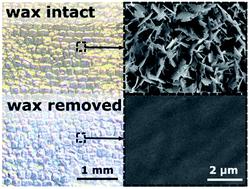当前位置:
X-MOL 学术
›
Faraday Discuss.
›
论文详情
Our official English website, www.x-mol.net, welcomes your
feedback! (Note: you will need to create a separate account there.)
Disordered wax platelets on Tradescantia pallida leaves create golden shine.
Faraday Discussions ( IF 3.3 ) Pub Date : 2020-04-16 , DOI: 10.1039/d0fd00024h Gea T van de Kerkhof 1 , Lukas Schertel 1 , Rebecca Nokjan Poon 1 , Gianni Jacucci 1 , Beverley J Glover 2 , Silvia Vignolini 1
Faraday Discussions ( IF 3.3 ) Pub Date : 2020-04-16 , DOI: 10.1039/d0fd00024h Gea T van de Kerkhof 1 , Lukas Schertel 1 , Rebecca Nokjan Poon 1 , Gianni Jacucci 1 , Beverley J Glover 2 , Silvia Vignolini 1
Affiliation

|
Plants have various strategies to protect themselves from harmful light. An example of such a protective mechanism is the growth of epicuticular nanostructures, such as a layer of hair or wax crystals. Most nanostructures are optimised to screen UV radiation, as UV light is particularly damaging for cellular tissue. We find that, contrary to the commonly found UV reflectance, the epicuticular wax crystals on Tradescantia leaves reflect strongly in the higher visible wavelength regime. Thus, they give the leaves a golden shine. We characterize the optical appearance of Tradescantia pallida ‘purpurea’ leaves by angularly resolved spectroscopy and compare the results to finite difference time domain simulations. We find that it is the disordered assembly of the wax platelets that is the crucial parameter to obtain the observed reflected intensity increase for higher wavelengths.
中文翻译:

Tradescantia pallida 叶子上无序的蜡片会产生金色光泽。
植物有各种策略来保护自己免受有害光线的伤害。这种保护机制的一个例子是表皮纳米结构的生长,例如一层头发或蜡晶体。大多数纳米结构都经过优化以屏蔽紫外线辐射,因为紫外线对细胞组织的伤害特别大。我们发现,与常见的紫外线反射率相反,紫檀叶上的表皮蜡晶体在较高的可见光波长范围内强烈反射。因此,它们赋予叶子金色的光泽。我们描述了白粉蓼的光学外观'purpurea' 通过角度分辨光谱分析离开,并将结果与有限差分时域模拟进行比较。我们发现蜡片的无序组装是获得观察到的更高波长反射强度增加的关键参数。
更新日期:2020-04-16
中文翻译:

Tradescantia pallida 叶子上无序的蜡片会产生金色光泽。
植物有各种策略来保护自己免受有害光线的伤害。这种保护机制的一个例子是表皮纳米结构的生长,例如一层头发或蜡晶体。大多数纳米结构都经过优化以屏蔽紫外线辐射,因为紫外线对细胞组织的伤害特别大。我们发现,与常见的紫外线反射率相反,紫檀叶上的表皮蜡晶体在较高的可见光波长范围内强烈反射。因此,它们赋予叶子金色的光泽。我们描述了白粉蓼的光学外观'purpurea' 通过角度分辨光谱分析离开,并将结果与有限差分时域模拟进行比较。我们发现蜡片的无序组装是获得观察到的更高波长反射强度增加的关键参数。











































 京公网安备 11010802027423号
京公网安备 11010802027423号